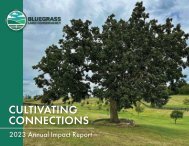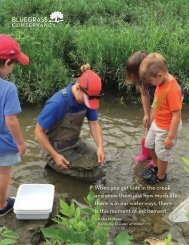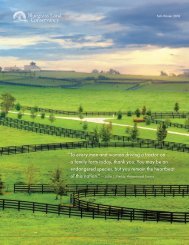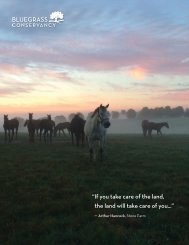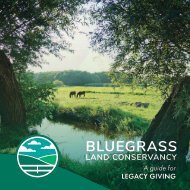BLC Conservation Easement Landowner Guide
A guide for Kentucky landowners: - What is a Conservation Easement? - Financial Benefits of Conservation Easements - About Land Trusts - Frequently Asked Questions - Landowner Stories
A guide for Kentucky landowners:
- What is a Conservation Easement?
- Financial Benefits of Conservation Easements
- About Land Trusts
- Frequently Asked Questions
- Landowner Stories
Create successful ePaper yourself
Turn your PDF publications into a flip-book with our unique Google optimized e-Paper software.
PART 5: FREQUENTLY ASKED QUESTIONS<br />
Does every conservation easement qualify for an income tax deduction?<br />
No. To qualify as a charitable contribution, conservation easement donations must:<br />
• Be perpetual, meaning continuing forever;<br />
• Be donated to a qualified organization (a land trust or governmental entity); and<br />
• Be donated exclusively for recognized “conservation purposes,” as set out in the<br />
Internal Revenue Code.<br />
Does a conservation easement have to be perpetual?<br />
For the donation to qualify for income and estate tax benefits, the conservation<br />
easement must be perpetual and legally binding on all future landowners.<br />
Can conservation easements be purchased?<br />
Yes, conservation easements can be purchased, though this is less often the case in<br />
Kentucky, as funding is very limited. There are a handful of federal, state, and local<br />
funding sources that can be utilized to purchase easements on farmland or natural<br />
lands of exceptional quality or lands that meet specific conservation metrics. Purchased<br />
conservation easements are sometimes referred to as “PDRs,” which stands for<br />
“purchase of development rights.” If funding is available to purchase an easement, the<br />
amount available can be less than the full value of the conservation easement. In such<br />
cases, the transaction may qualify as a “bargain sale” that may result in a potential<br />
tax benefit to the landowner. The amount of the benefit (tax deduction) generally will<br />
be the full, appraised value of the conservation easement, less the amount paid to<br />
the landowner. <strong>Conservation</strong> easements are valued by independent, qualified, and<br />
licensed appraisers.<br />
What are the “conservation purposes” recognized by the Internal<br />
Revenue Code?<br />
The Internal Revenue Code Section 170(h) requires that the conservation easement<br />
donation meet one or more of the following conservation purposes:<br />
• Preserves land for public outdoor recreation or education;<br />
• Protects relatively natural habitats of fish, wildlife or plants or similar ecosystems;<br />
• Preserves open space–including farms, ranches, pasture land or forests–either for<br />
public scenic enjoyment or in keeping with a clearly delineated federal, state, or<br />
27




